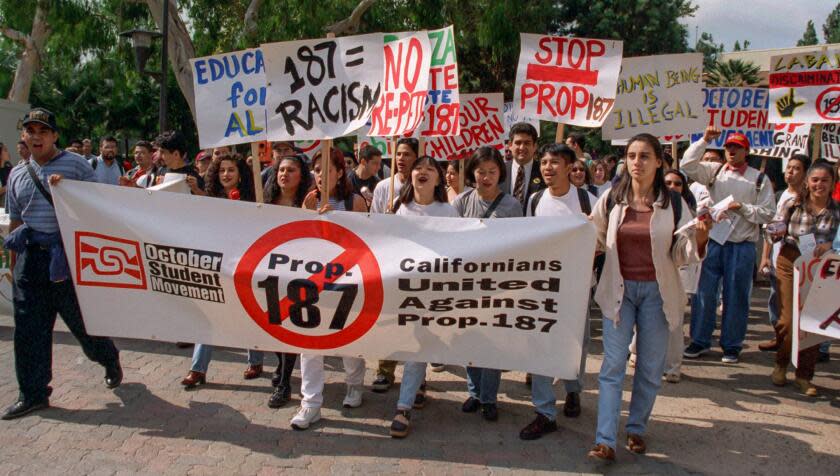This misunderstanding of the Latino vote may be biggest blind spot in American politics

Thirty years ago, Californians passed a ballot measure that catalyzed a generation of Latino voters. Proposition 187 aimed to deny virtually all public services to the undocumented and their children. Written largely in response to the transformative demographic change occurring in California at the time, the measure triggered a seismic shift in racial politics and galvanized Latino activists, some of whom would eventually hold the state’s most powerful political offices. The plight of undocumented and recent immigrants became an indelible part of the political narrative for a generation of Latinos and their leaders.
Something remarkable and unprecedented happened in 1994, the year of the Proposition 187 campaign. Nearly two-thirds of Latinos voted against the measure as a bloc across parties, genders, generations and national origins. They melded into an ethnic political coalition built on the narrative of the undocumented and migrant experience.
As Latino politicians amassed power and numbers over the ensuing decades, however, a curious phenomenon emerged: Latino voter participation began to drop dramatically. To this day, Latinos vote at lower rates than any other race or ethnicity in California.
Read more: Opinion: Are Latino voters really defecting in droves to Republicans? Not according to our data
At the same time, nearly every high-quality survey of Latino voters identified jobs and the economy as their top concerns. Latinos disproportionately suffer from California’s economic challenges, from housing affordability to high poverty to educational barriers. And they have been clamoring for an ambitious economic agenda from Sacramento, especially its growing number of Latino politicians. And yet no campaign or party has developed a working-class economic agenda to answer Latinos’ concerns.
Instead, Latinos are still widely misunderstood as an aggrieved racial minority motivated by immigration, farmworker and border issues. This is one of the most striking blind spots in American politics: The fastest-emerging group of voters in the country is quantifiably telling political leaders what they need and want to hear, and yet both parties persist in the belief that they understand Latinos better than they understand themselves.
The most rapid growth in Latino participation is taking place among third- and fourth-generation, U.S.-born voters. And even in California, the latest evidence shows that the catalyzing immigration politics of the last century are no longer resonating in this century. Latino voting behavior is undergoing a generational shift.
Read more: Opinion: Biden's struggle among Latino voters is real. Here's why and what he can do about it
California political data expert Paul Mitchell noted in Capitol Weekly recently that in Los Angeles County, which is home to more Latinos than any other county in the country, the share of registered voters who are foreign born had plummeted from 55% to less than 9% over the last two decades. This is an extraordinary transformation of the Latino electorate. Moreover, almost 40% of Latino voters weren't even alive during the formative political events of the Proposition 187 era.
California has long been the great Latino exception. For one thing, immigrants make up more of California’s population than any other state’s: Our 10.4 million immigrants represent 27% of California’s population and 23% of the whole nation’s foreign-born.
Despite this rich immigrant tapestry, however, California’s Latinos are overwhelmingly U.S.-born and growing more so. California was not exhibiting the measurable rightward shift of Latino voters that was evident in other states until recently, but now it is. It’s just been harder to see due to the state’s large number of older immigrant and left-leaning voters.
Economic frustration could be a key reason for the shift. A recent study reported that only 9% of Latino households could afford the state’s median home price. Fifty-five percent of California families in the bottom 10% of incomes are Latino or Black. By virtually every economic metric, in a state with more Latino elected officials than most, Latinos aren’t doing well.
Housing affordability and other economic issues are moving Latinos off the sidelines and out of their traditional pattern of supporting Democrats in great numbers, so much so that even the Golden State is no longer an outlier. Robb Korinke of California Target Book (a partner in my firm, GrassrootsLab) found measurable Latino voter registration shifts away from Democrats in every one of California’s competitive congressional districts since the midterm election. At the same time, the performance gap between Republicans and Democrats in Latino-dense state legislative districts has closed considerably.
Are we witnessing a transformation of the Latino vote? Registration, turnout and other data point strongly in that direction. It’s time for policymakers, many of whom came of age with the narrative that defined the end of the last century, to recognize that we’re on the precipice of a new Latino political identity in a new Latino century.
Mike Madrid is a political consultant and the author of the forthcoming “The Latino Century: How America’s Largest Minority is Changing Democracy,” from which this was adapted.
This story originally appeared in Los Angeles Times.


